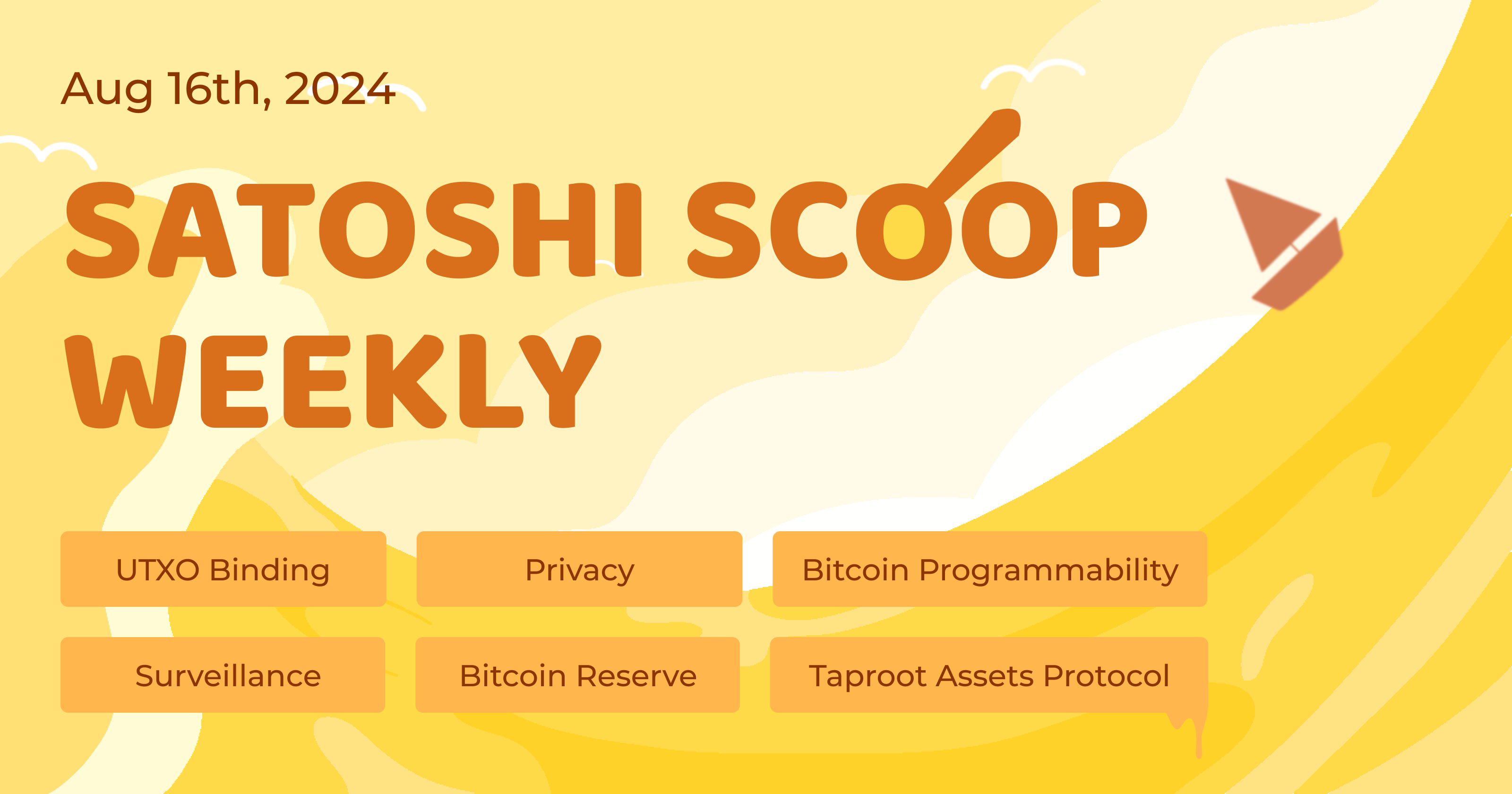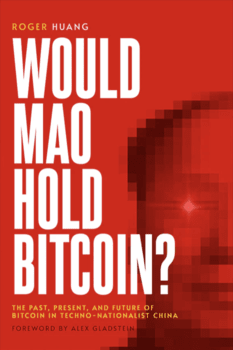Satoshi Scoop Weekly, 16 Aug 2024
 Cryptape
CryptapeTable of contents
- Crypto Insights
- Bitcoin Privacy-Friendly dApps and Usage Tips
- OP_NET: Bitcoin-Aligned Smart Contract Meta-Protocol
- Comparative Analysis: Chain Abstraction, Intent, and Intent Abstraction
- UTXO Binding: Comparative Analysis of BTC Smart Contract Solutions - Arch Network, RGB, RGB++
- Arthur Hayes on Elections, Bitcoin, and Bitcoin's Future Narrative
- UN Cybercrime Convention Draft: Widespread Abuse of Surveillance Powers, Overruling Bank Secrecy, Unshared Private Information No Longer Safe
- Top Reads on Blockchain and Beyond

Crypto Insights
Bitcoin Privacy-Friendly dApps and Usage Tips
- Discover a good privacy flow for common BTC transactions.
OP_NET: Bitcoin-Aligned Smart Contract Meta-Protocol
OP_NET is a Proof of Authority Bitcoin-Aligned Smart Contract Meta-Protocol, similar to Ordinals, BRC-20, Runes, Counterparty. The multi-sig-based bridge allows users to transfer Bitcoin into the protocol, requiring the burning of 330 sats gas fee.
OP_NET nodes use WASM VM to execute WASM smart contracts, supporting Assembly Script, Rust, Python, TypeScript, etc.
%[https://x.com/BobBodily/status/1821678955193364657?refsrc=twsrc^tfw|twcamp^tweetembed|twterm^1821678955193364657|twgr^971721fffd89702a023b3011da5be3ac9bfe8e79|twcon^s1&ref_url=https://www.notion.so/cryptape/CW-baf0dd0d642443d2aadf14bb4090cd7a]
Comparative Analysis: Chain Abstraction, Intent, and Intent Abstraction
Chain Abstraction (CA) and Intent-Centric solutions are two approaches aimed at achieving automated asynchronous interoperability across heterogeneous trust domains. Both introduce the concepts of "counterparties" and "cross-chain proofs" to address this issue, but differ in their respective structures.
Intent-centric approach provides architectural advantages, offering users outcome-based guarantees and optimizing the outcome state and latency through counterparty selection. It is more scalable for bespoke destinations. However, to achieve this, the proof process needs to be reversed, and the proof obligation placed on the solvers’ network.
Intent Abstraction (IA) provides an abstraction for solvers in heterogeneous proof obligations. More information on this approach can be found in this post.
UTXO Binding: Comparative Analysis of BTC Smart Contract Solutions - Arch Network, RGB, RGB++
Arch Network, RGB, and RGB++ each seeks to enhance Bitcoin’s programmability natively:
Arch Network introduces a zero-knowledge virtual machine and a corresponding network of verifier nodes, recording state changes and asset states through aggregated transactions.
RGB uses an off-chain client-verified smart contract solution, where the state changes of smart contracts are recorded in Bitcoin's UTXOs. Despite its certain privacy advantages, it is cumbersome to use and lacks contract composability. Its development is currently rather slow.
RGB++ enhances the RGB framework by using the chain itself as a client verifier with consensus, providing a metadata asset cross-chain solution and allows for transfers between any UTXO chain.
Arthur Hayes on Elections, Bitcoin, and Bitcoin's Future Narrative
Key insights from Arthur Hayes's two recent interviews with DLNews and Nic Puckrin (Coin Bureau).
On Election’s Impact on Crypto Market
“They think Trump says the right things and so he’s going to make it happen faster. Trump or Harris, it doesn’t matter.”
“Both the Trump administration or Harris administration will print the money. They do it in different ways. But the money will be printed. And so your crypto is going to go up — the path could be very wonky, but at the end of the day, we know where it’s going.”
On Bitcoin Reserve
“I find it [Bitcoin reserve] almost impossible that that will get done, even if Trump is elected. You’re going to need to have a certain amount of people vote for this and if, you know, this is going to somehow negatively impact the US Treasury or Fed or visibility to maintain a US Treasury market.”
AH emphasizes that although both the Democratic and Republican parties will eventually take measures to support their voters, the crypto industry should be more proactive in asking political candidates to take action, rather than expecting them to deliver on their promises after the election.
Market > Technolog
- When discussing Aptos and Solana, Arthur emphasized that although both use the Move programming language, he does not believe that technology itself is the key factor. He pointed out that it is the actual usage and demand of users that ultimately determine the success of cryptocurrencies, rather than technical indicators such as transactions per second. He believes that when financial institutions move to Web 3.0, they are focused on how to actually operate on public blockchains rather than technical details.
On DeFi
- AH pointed out that while some have criticized Ordinals as garbage and spam on the blockchain, this "junk" actually pays transaction fees, thereby supporting the operation of the network. He believes that similar ways should be created to allow DeFi applications to exist on the chain and pay for their use.
On Future Narrative of Bitcoin Ecosystem
- AH mentioned the Airheads Ordinals project he recently launched. He believes that as the Bitcoin market recovers, Bitcoin holders will become richer and will seek some digital assets that can reflect cultural value. He emphasized that as a native digital artifact of Bitcoin, Ordinals have an essential difference from traditional NFTs, which makes it uniquely attractive in the market.

UN Cybercrime Convention Draft: Widespread Abuse of Surveillance Powers, Overruling Bank Secrecy, Unshared Private Information No Longer Safe
The United Nations has finalized the draft of the United Nations Convention against Cybercrime, proposed by Russia and China in 2017. The Convention aims to “strengthening international cooperation for combating certain crimes committed by means of information and communications technology systems and for the sharing of evidence in electronic form of serious crimes”.
The largest hacker association in Europe, the Chaos Computer Club (CCC), criticizes the Convention for its invasive surveillance measures, arguing that it could infringe upon human rights and pose risks to IT security experts and journalists. The Convention has extensive surveillance provisions, including real-time collection of telecommunications metadata and interception of communications, without establishing sufficient legal protections against potential abuse, so that "widespread abuse of surveillance powers can be foreseen".
Another article UN Cybercrime Convention To Overrule Bank Secrecy lists specific clauses, such as:
Article 7 on “illegal access”: "Each State Party shall adopt such legislative and other measures as may be necessary to establish as a criminal offense under its domestic law, when committed intentionally, the access to the whole or any part of an information and communications technology system without right."
Article 31 on "freezing, seizure and confiscation of the proceeds of crime": The treaty mandates member states to provide "government, bank, financial, corporate or business records", the identification and tracing of "proceeds of crime, property, instrumentalities or other things for evidentiary purposes", and to recover "proceeds of crime" on behalf of requesting state parties.
The Electronic Frontier Foundation also raises concerns about the Convention’s broad definition of “electronic data”, which could include “documents saved on personal computers or notes stored on digital devices. In essence, this means that private unshared thoughts and information are no longer safe. Authorities can compel the preservation, production, or seizure of any electronic data, potentially turning personal devices into spy vectors regardless of whether the information has been communicated”.
Top Reads on Blockchain and Beyond
New Book: Would Mao Hold Bitcoin?

Author Roger Huang introduction his book, which explores the intersection of China's techno-nationalist rise since 1978 and the emergence of Bitcoin. He examines the clash between China’s top-down state-driven tech innovation model, and the bottoms-up, open source development of Bitcoin.
The book is not fully available online, but a summary and this podcast provide further insights:
The foreword is written by Alex Gladstein, Chief Strategy Officer at the Human Rights Foundation:
Understanding Taproot Assets Protocol
The Taproot Assets Protocol (TAP), formerly Taro, is a new Taproot-powered protocol for issuing assets on the bitcoin blockchain that can be transferred over the Lightning Network for instant, high volume, low fee transactions. At its core, Taproot Assets taps into the security and stability of the bitcoin network and the speed, scalability, and low fees of Lightning.
This section features two articles, a guide to TAP and how to use it to create and transfer assets.
It covers:
TAP features and limitations
Basic concepts: public-key cryptography, cryptographic hashes, Merkle trees, and Bitcoin UTXO
Issuing and transferring assets
Taproot Assets on Lightning
Exchange rates
Understanding Taproot Assets Protocol: How TAP Creates and Transfers Assets
This article explains how TAP is used to create and transfer assets, with a focus on bip-tap and the Sparse-Merkle Tree bit-tap-ms-smt.
Subscribe to my newsletter
Read articles from Cryptape directly inside your inbox. Subscribe to the newsletter, and don't miss out.
Written by
